
 For English version please click here
For English version please click here
Il Myrionema amboinense (anche conosciuto come amboeniensis) è un idrozoo originario dell’Oceano Atlantico dell’Ovest, scoperto per la prima volta da Pictet nel 1893. Per noi acquariofili è divenuto tristemente importante in quanto si è caratterizzato come una delle peggiori pesti presenti in acquario.
Leggi tutto l’articolo cliccando qua: Myrionema amboinense.

Myrionema in tutto il loro splendore

Lotta per la sopravvivenza fra Myrionema e Pocillopora
The Myrionema amboinense (also known as amboeniensis) is an hydroid, order od hydrozoa, originating in the Atlantic West, first discovered in 1893 by Pictet. For us it has become sadly mportant since it is characterized as one of the worst pests in the aquarium.
You can read the article and see all the photos by clicking here: Myrionema amboinense
Biologicamente fa parte dell’Ordine Anthoathecata (o Anthomedusae), subordine Filifera, e della Famiglia Eudendriidae (anche se fishbase.org lo cataloga come Pandeidae), generalmente si trova in natura in un ambiente Pelagico con clima Subtropicale.
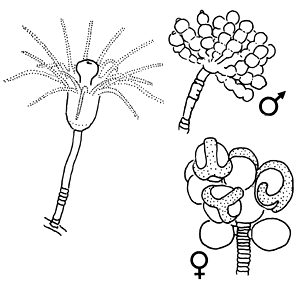
Eudendriidae
Gli idrozoi sono in genere caratterizzati dall’essere piccoli animali predatori in maggior parte presenti in acqua di mare, e spesso sono simili ai coralli, nel senso che oltre ad avere un primitivo apparato digerente e quindi la possibilità di nutrirsi direttamente dall’acqua riescono in alcuni casi ad essere colonizzati da alghe simbionti, le zooxhantelle, che sintetizzano la maggior parte di quanto hanno bisogno direttamente dalla luce del sole e forniscono all’organismo che le ospita sostanze scomposte pronte per la digestione. In poche parole i Myrionema sono animali perfetti.
Il problema maggiore di questi animali è che a prima vista, se non li si conosce, sembrano graziose alghe di color marroncino che ravvivano il nostro acquario con il loro movimento assecondando il flusso creato dalle nostre pompe di movimento. Purtroppo se le condizioni sono per loro ottimali, e fortunatamente non lo sono in tutti i casi, proliferano fino a diventare infestanti e non ci sono metodi infallibili per eliminarli. La stessa rimozione meccanica non è assolutamente sufficiente a fermarli, in quanto in breve tempo ricopriranno nuovamente la zona interessata.
Perché sono pericolosi e per quali organismi lo sono?
I Myrionema non hanno veleno e non sono urticanti e si tolgono facilmente dall’acqua, quindi perché sono pericolosi? Perché in vasche predisposte e con una forte illuminazione, tendono a proliferare e quindi a diventare infestanti, data la loro crescita velocissima ed inarrestabile. Come è possibile vedere dalle foto, grazie alle ridotte dimensioni si inseriscono in ogni buco e tolgono luce al corallo che per vivere è costretto a lasciar morire il proprio tessuto.
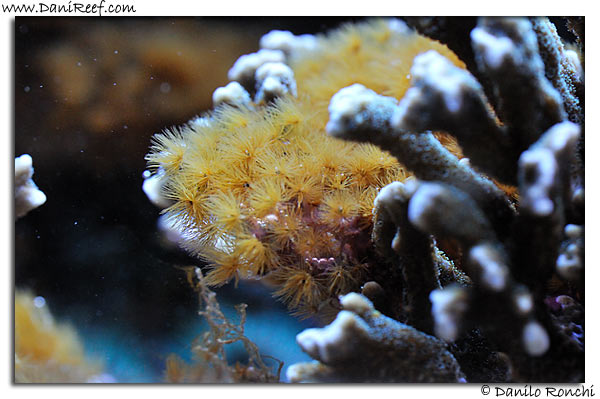
Myrionema all’interno di una Montipora
I coralli più infastiditi da questo idrozoo sono ovviamente i coralli sps ed lps, cioè i coralli a scheletro calcareo che viene percorso dal Myrionema fino ad avvolgere il corallo. I coralli molli invece sono meno sensibili a questa piaga in quanto non offrono il fianco all’arrampicata degli idrozoi infestanti.
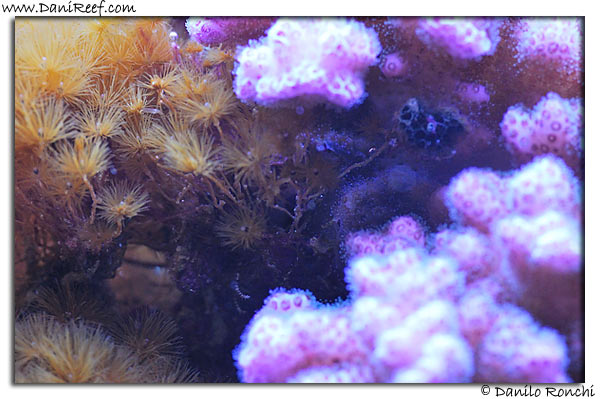
Particolare della crescita stolonifera vicino ad una Pocillopora
La rimozione meccanica è la via più veloce per prendersi cura di vaste aree colonizzate da questi organismi, per farlo io mi sono munito di una pinza ricurva che mi aiuta nello strapparli alla radice. La rimozione meccanica dovrebbe essere vantaggiosa in quanto una volta strappato l’organismo non dovrebbe più essere in grado di colonizzare l’ambiente. Il problema è che se rimane anche solo un pezzettino microscopico di radice da questa si origina un nuovo stolone e si ricomincia.
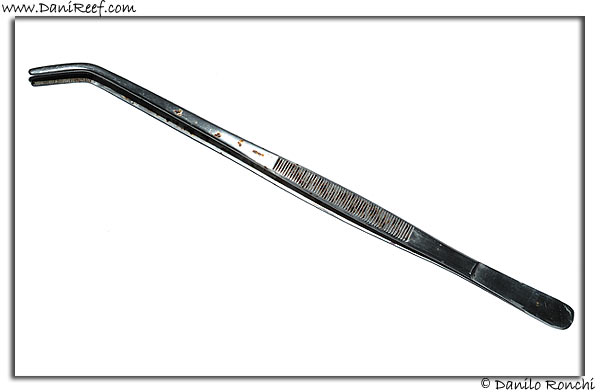
Pinze ricurve usate con successo nella rimozione meccanica dei Myrionema
I Possibili Rimedi
Nel corso del tempo ho provato sulla mia vasca diversi possibili rimedi, mi sono informato fino all’inverosimile ed ho contatto diversi acquariofili esperti, come ad esempio Anthony Calfo su wetwebmedia.
Purtroppo tutto quello che è venuto fuori è che non vi è, ad oggi, nessun metodo conosciuto per la loro totale e sicura rimozione, anzi sono tante le testimonianze di acquariofili che hanno distrutto e smantellato intere vasche pur di toglierseli di torno.
E’ necessario in ogni caso sottolineare che non in tutte le vasche si comportano allo stesso modo, esistono vasche infatti in cui sono presenti ma non proliferano e non crescono, e dove quindi non rappresentano una minaccia almeno in tempi brevi.
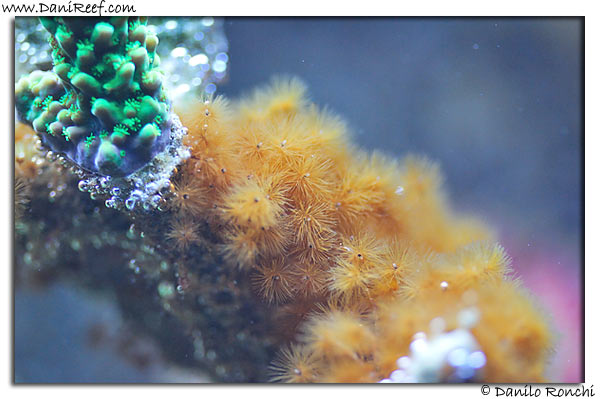
Myrionema all’attacco di una Acropora nobilis
Calfo mi suggerì di mantenere un bassissimo livello di nutrienti, cosa che ho fatto per lungo tempo ma senza nessun risultato tangibile, arrivando anzi alla sofferenza dei coralli stessi per mancanza di nutrimento. La motivazione è da ricercarsi in quello che poi ho scoperto successivamente e che ho riportato nelle prime righe di questo articolo, e cioè che i Myrionema come i coralli, si nutrono principalmente di luce, e quindi togliere loro i nutrienti non porta ad eccessivi benefici se non ad uccidere i coralli che invece vorremmo proteggere.
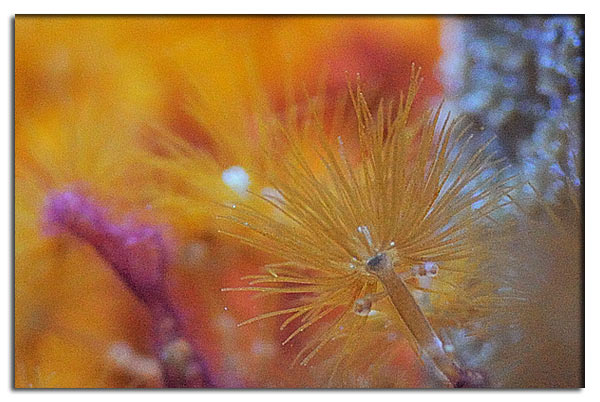
Ingrandimento di uno stolone di Myrionema
Rimedi Biologici
Uno dei primi rimedi di cui si è parlato è senza dubbio il riccio Salmacis bicolor, citato anche in un articolo della rivista Coralli di qualche anno fa. In effetti il riccio è un discreto mangiatore di Myrionema, anche se non sono riuscito a capire il motivo per cui se ne ciba, e cioè se gli piacciano realmente oppure se li mangia solo in quanto li trova sulla sua strada. Quello che ho notato è che però se il riccio capita su una piccola roccetta infestata, la pulisce completamente girandogli attorno.
Posto in questi termini il problema sembra abbondantemente risolto, invece il riccio è per sua natura estremamente lento, e pur avendone avuti anche 3 contemporaneamente nella mia vasca, i Myrionema hanno continuato la propria vita florida incuranti di questo tipo di minaccia.
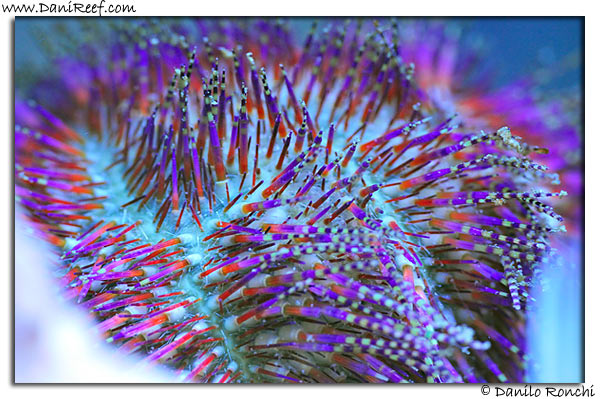
Particolare di riccio Salmacis bicolor
Un altro riccio che sembra spazzolarli con diligenza è il solito Diadema setosum, ma anche qua il problema è sempre e comunque uno solo, il riccio è troppo lento, e tra l’altro non riesce ad entrare in tutti gli anfratti dove ci sono i Myrionema.
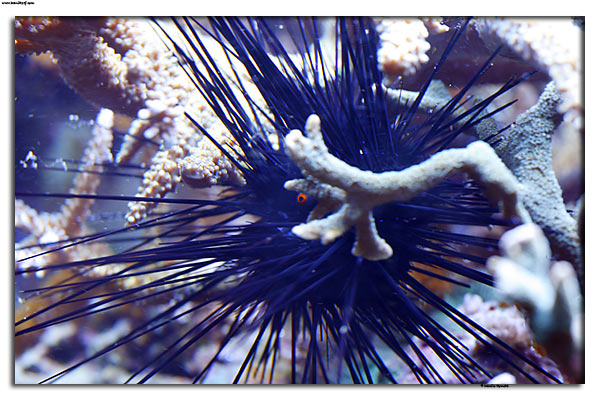
Riccio diadema setosum
Pesci Predatori
Sono state riportate esperienze di pesci che se ne cibano anche se non in maniera specifica e senza la sicurezza che ogni pesce di una determinata specie se ne nutra. La famiglia di pesci maggiormente rappresentata in questo contesto sono gli Angeli.
Visto che il problema dei Myrionema si presenta maggiormente in vasche dedicate ad sps e ad lps, come ricordato sopra, e visto che in una vasca di molli tutto sommato non creano tutti questi fastidi che invece vanno a creare appunto in una vasca di coralli duri, non sempre è possibile inserire nel nostro acquario un pesce angelo e quelli che si caratterizzano dall’essere più facilmente inseribili sono senza dubbio i Centropyge.
Interpellando la comunità acquariofila italiana e mondiale sui vari forum ho scoperto che gli angeli che hanno una probabilità elevata di mangiare i Myrionema e che sono sufficientemente reef-safe sono due, il Centropyge acanthops ed il Centropyge loriculus. Se si ha la fortuna di trovarne uno che se ne ciba con gusto ci si troverà la propria vasca libera da infestazioni in relativamente poco tempo.
Io ho un acanthops in vasca da lungo tempo ormai, ma non ha mai mostrato interesse verso questi idrozoi.
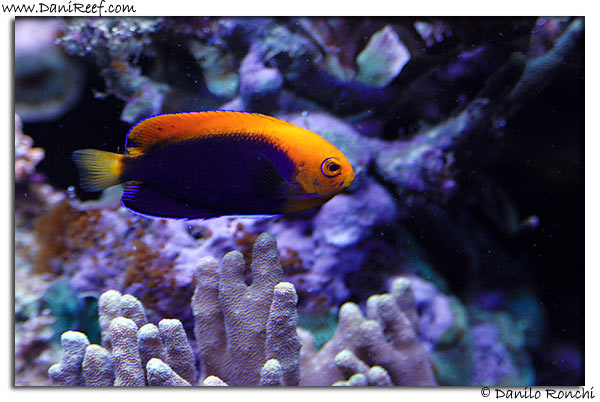
Centropyge acanthops

Centropyge loriculus
L’ultimo angelo di cui si parla con continuità nel successo della rimozione dei Myrionema è il Pomacanthus imperator, pesce che però per via della stazza e delle abitudini alimentari, è sconsigliato in una vasca di invertebrati.
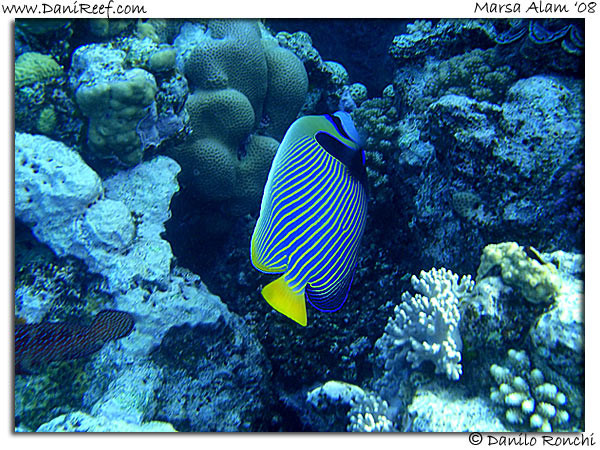
Splendido esempio di Pomacanthus imperator in natura
La Dolabella auricolaria (o capra di mare) è fino ad ora il rimedio più efficace trovato, ed è l’animale con la più alta probabilità di rimozione totale e definitiva. Chi ha inserito una Dolabella nel proprio acquario è rimasto contento dei risultati, perché chi più chi meno tutti questi lumaconi si sono dati da fare nel rimuovere i Myrionema. Nella mia vasca ho avuto un risultato ottimale all’inizio, dove sembrava fossero completamente spariti e dove ne rimanevano solo in una parte in centro della vasca dove la corrente era maggiore, poi complice il cambio di una pompa, la Dolabella ha smesso di mangiarli con continuità ed il risultato lo potete vedere nelle foto di questo articolo, anche se devo far notare che la vasca è stata abbandonata a se stessa senza alcuna rimozione di Myrionema al fine di completare questo articolo per circa quindici giorni.
Dati comunque i risultati ne acquisterò diverse nella speranza che tutte insieme e con la competizione mi riescano a togliere da questo empasse.
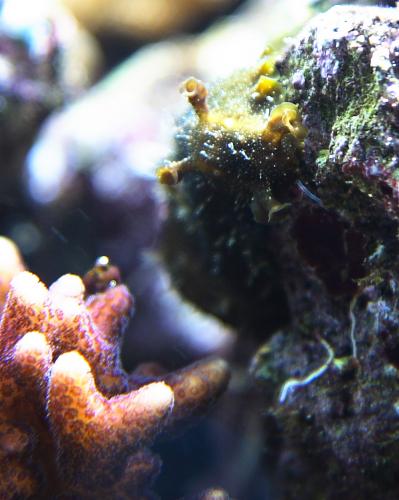
Dolabella auricolaria nella vasca di Arriva Jack
Rimedi impossibili
Al fine della rimozione dei Myrionema si è tanto parlato di un nudibranco la Pterolidia, che oltre ad essere praticamente introvabile non vi è nessuna testimonianza che se ne cibi realmente, ma si pensa che possa farlo perché si nutre di altri idrozoi simili ai Myrionema.
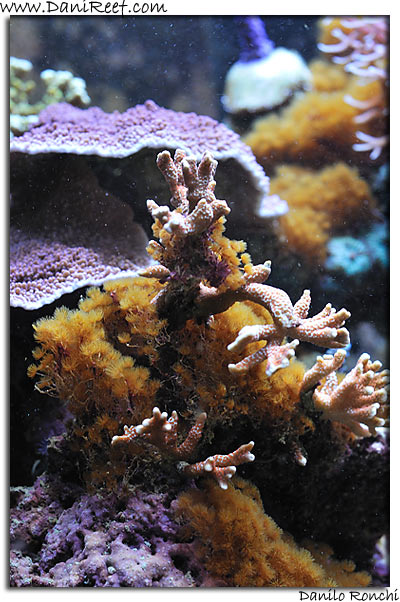
Myrionema all’attacco di una Montipora samarensis
Rimedi parzialmente utili
Come scritto nell’introduzione i Myrionema sono dipendenti quasi totalmente dalla luce, e quindi un rimedio può essere quello di ricoprire la parte interessata con della carta stagnola per evitare che vi arrivi la luce. Questo rimedio potrebbe essere sufficiente solo ed esclusivamente se vi sia una piccola porzione da coprire ed in ogni caso non è sicura nel lungo periodo, quindi io la sconsiglio a priori.
C’è chi ha suggerito l’uso di Joes Juice e di colla epossidica bicomponente, ma data la tipologia dell’animale non è combattendo una piccola porzione di territorio che si riesce ad estirparlo, perché la velocità di propagazione in vasche predisposte è velocissima, e quindi i Myrionema riprenderebbero a colonizzare l’area partendo da un’area limitrofa o nascosta.
L’uso del prodotto Zeospur2 contribuisce a far cadere gli stoloni dal Myrionema lasciando il solo stolone principale, ma nel corso del tempo si è dimostrato fallace in quanto l’animale ricresce prima di un successivo dosaggio, e in ogni caso non tutti i Myrionema vengono uccisi.
E’ ovvio che la sinergia di metodi biologici e chimici può portare a risultati importanti nella lotta contro questi idrozoi.
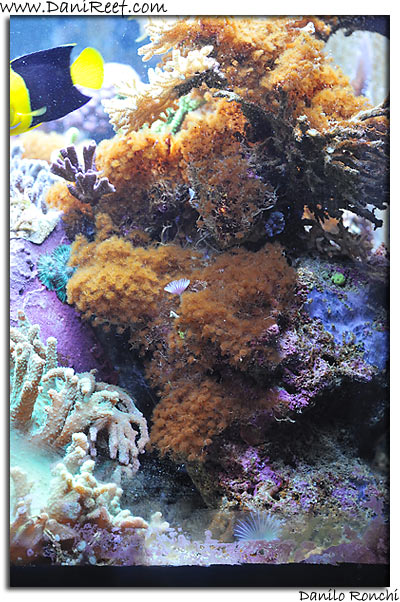
Myrionema e Seriatopora caliendrum
Conclusioni
Spero quindi con questo articolo di avervi dato qualche possibile rimedio e di avervi sensibilizzato sull’esistenza di questo animale, in modo che se lo doveste vedere su una piccola roccia nel vostro acquario sapeste come comportarvi… togliendo subito quella roccia… se invece lo avete già in acquario ma non si è dimostrato infestante… siete fortunati e vi consiglio di prendere delle contromisure biologiche prima che sia troppo tardi.
Per qualsiasi informazione in merito potete contribuire in questo post aperto sul forum di Acquaportal: Myrionema: come debellarli?

Il subdolo attacco dei Myrionema parte dalla base
The Myrionema amboinense (also known as amboeniensis) is an hydroid, order od hydrozoa, originating in the Atlantic West, first discovered in 1893 by Pictet. For us it has become sadly important since it is characterized as one of the worst pests in the aquarium.

Myrionema in all their glory

Struggle for survival between Myrionema and Pocillopora
Biologically part of Anthoathecata (or Anthomedusae), the alternative Filifera, and Family Eudendriidae (even if the catalogs fishbase.org as Pandeidae), generally occurs naturally in an environment with Pelagic Subtropical climate.

Eudendriidae
The hydroids are generally small predators most present in sea water, and often are similar to coral, because that besides having a primitive digestive system and therefore the possibility of feeding directly into the water, they can have algae symbionts upon them, the zooxhantelle, that provide feeding for each other. In short, the Myrionema are animals perfect.
The biggest problem is that at first sight, unless you know them, they seem very cool, a shiny brown algae that brighten our aquarium with their movement according with the flow created by our movement pumps. Unfortunately, if the conditions are optimal for them, and fortunately they are not in all cases, they proliferate and there are no foolproof methods to remove them. The mechanical removal is never enough to stop them, as soon they’ll cover the area again.
Why are so dangerous?
Myrionema hasn’t poison and do not sting and they’re easily removed from the water, so why are so dangerous? Because in some tanks with a strong light, they tend to proliferate because of their fast growth and unstoppable. As you can see from the photos, thanks to the small size will fit into each hole and so they cover the light for our living coral that are forced to bleach.

Myrionema within a Montipora
The corals most annoyed by this hidroid are obviously sps corals and lps, because Myrionema grows on their skeleton. The soft corals are less susceptible to this scourge as they does not provide climbing path for hydrozoa.

Particular near a Pocillopora
The mechanical removal is the quickest route to take care of large areas colonized by these bodies, to do that I use a forceps that helps me in the snatch them at the root. The mechanical removal would be beneficial because once snatched the stolon should no longer be able to colonize the environment. The problem is that if it remains just a piece of microscopic root, a new stolon originates from this and again.

Forceps used with success in the mechanical removal of Myrionema
The Possible Remedies
Over time I tried it on my tank several possible remedies, I contacted and read son many articles and forum and I contacted also Anthony Calfo on wetwebmedia.
Unfortunately, all that came out is that there is, to date, no method known for their full and safe removal, but many are the testimonies of aquarium keeper that have destroyed and dismantled the entire tank to eliminate them.
But I must admit that not all the tanks are behaving the same way, there are tanks where they don’t proliferate, and therefore they’re not a threat at least in the short term.

Myrionema near Acropora nobilis
Calfo suggested me to maintain a low level of nutrients, which I have done for a long time but without any tangible result, reaching even to the suffering of the corals themselves for lack of nourishment. The justification was based on what I discovered and I reported in the first lines of this article, the Myrionema as corals feed mainly of light, and then remove the nutrients does not lead to a large benefits if not to kill the corals who want to protect.

Magnification of a stolon of Myrionema
Biological Remedies
One of the first remedies mentioned is undoubtedly the sea urchin Salmacis bicolor, also mentioned in an article in the italian magazine “Coralli” a few years ago. In fact, the sea urchin is a good eater of Myrionema, although I could not understand why eating it, if he likes it or if he eats them only when he walks upon them. What I noticed is that if the salmacis walks on a small rock full of Myrionema, he cleans it almost entirely.
So the problem seems quite satisfactorily resolved, however, the sea urchin is by nature extremely slow, and although I had 3 at once in my tank, the Myrionema continued to grow up heedless of this type of threat.

Particular of sea urchin Salmacis bicolor
The Diadema setosum is another sea urchin which seems to eat them with the usual care, but even here the problem is always the same, the sea urchin is too slow, and among other things he can not go into all the holes where myrionema live.

Sea urchin diadema setosum
Predators Fish
I’ve collected many experiences of fish eating them, but there is no way to know if a fish can eat them before putting in our tank. The family of fish most represented in this context are the Angels.
Since the problem of Myrionema is more belonged to sps and lps tanks, as mentioned above, is not always possible and safe to put one or more angel fish in our aquarium, so the preferred fish into this family are certainly the Centropyge.
Asking the italian and world aquarium community I discovered that the angels that have a high probability to eat Myrionema and are sufficiently reef-safe are two, the Centropyge acanthops and Centropyge loriculus. If you are fortunate enough to find one that eating it with appetite you’ll find your tank free of infestation in relatively short time.
I have one acanthops in my tank for a long time now, but he never showed interest in these hydrozos.

Centropyge acanthops

Centropyge loriculus
The Pomacanthus imperator is the last angel referred to eat them, but he it’s a challenge to try to put into our tank, for his size and for eating habits.

Splendid example of Pomacanthus imperator in the wild
Dolabella auricolaria is so far the most effective remedy found, and the animal with the highest probability of total and definitive removal. Anyone who has putted a Dolabella in his aquarium has been pleased with the results, because all this snails, more or less, work to remove the Myrionema. In my tank, I had an optimal result at the beginning, where it seemed they were completely gone and where they remained only in the central part of my tank where the flow was increased, then maybe thanks to a new pump, the Dolabella stopped to eat with continuity and you can see the result from photos of this article, although I must point out that the tank has been abandoned to itself without removing Myrionema in order to complete this review for about fifteen days.
But I’m sure I will buy several one, in the hope that all together and with the competition, I can take away from this impasse.

Dolabella from the tank of ArrivaJack
Impossible Remedies
I found that someone think to use a nudibranchia Pterolidia against myrionema, but in Italy is virtually impossible to buy one, and there is no evidence that will eat them really, but many think that could do it because it feeds on other hydrozoans much like Myrionema.

Myrionema, the attack of a Montipora samarensis
Remedies partially useful
As written, the Myrionema are dependent almost entirely from light, and then a remedy may be to hold one aluminum foil over them to block the light. This may be sufficient only if there is a small portion to be covered and in any case is not safe in the long run, then I do not recommend it.
Some suggested the use of Joes Juice and bicomponent epoxy glue, but given the nature of the fight is not important to clean a small area, because thanks to their speed of propagation they colonize the area again from a neighboring one.
The use of the product Zeospur2 helps bring down the grow of Myrionema leaving only the main stolon after dosing it, but over time has proved fallacious because the animal regrows before a subsequent dose, and in any case not all Myrionema are killed.
It ‘obvious that the synergy of biological and chemical methods can lead to important results in the fight against this hydroid.

Myrionema and Seriatopora caliendrum
Conclusions
So I hope with this article to have given some possible remedy and awareness of the existence of this animal, so if you see him on a small rock in your aquarium you know how to react … immediately removing the rock … if you have them into your tank, but they had not proliferate… you are very lucky and you should take biological countermeasures before it is too late.
If you have any information about them, you can write on this page

The attack of Myrionema






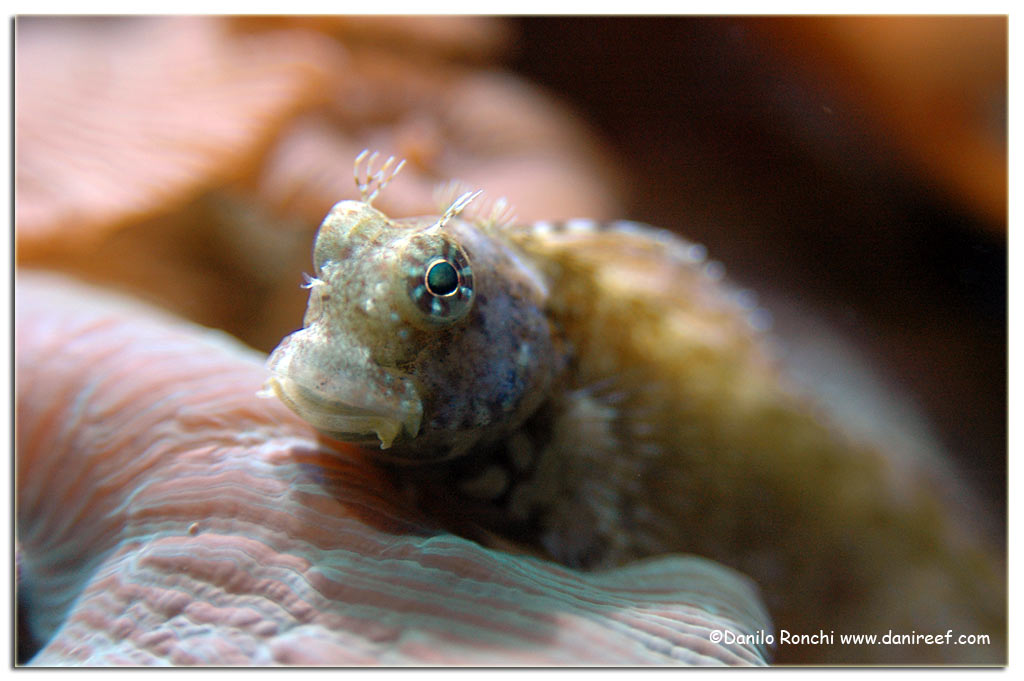
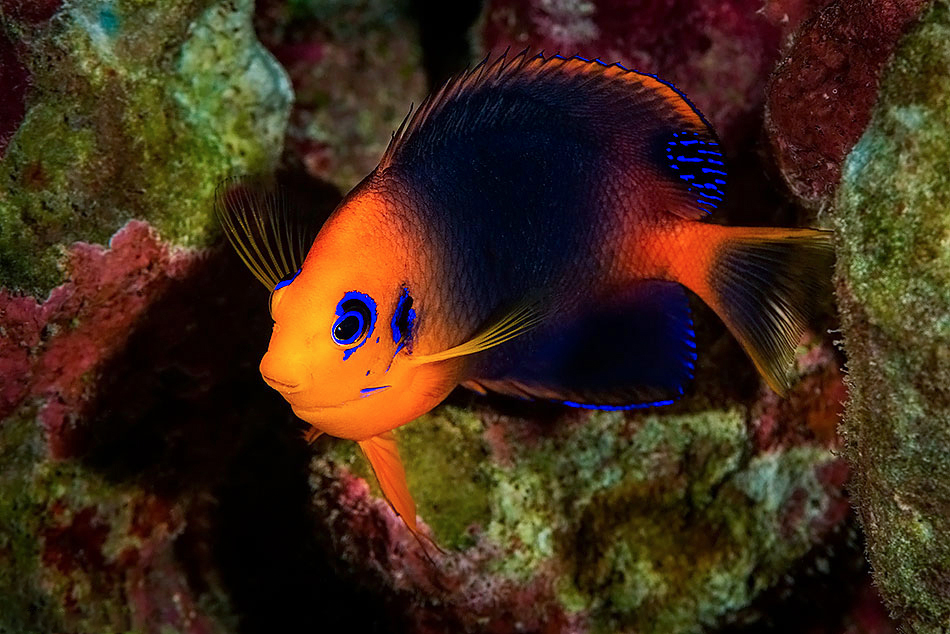
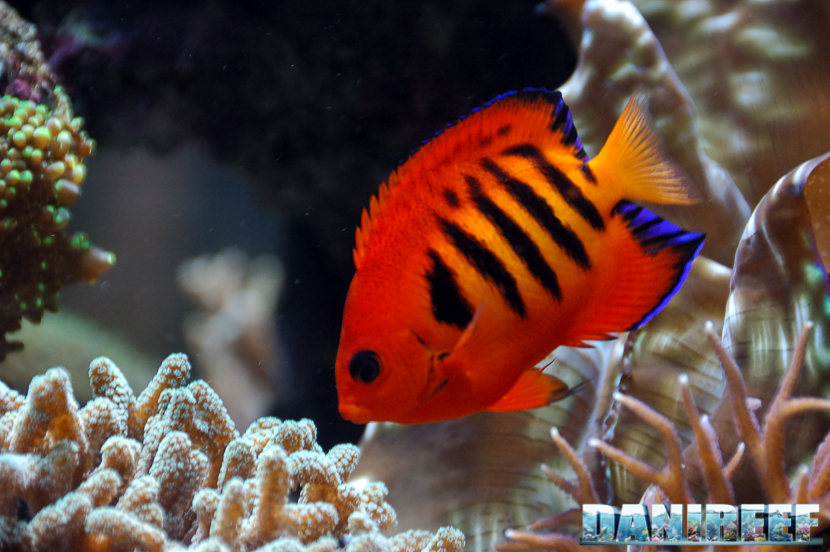
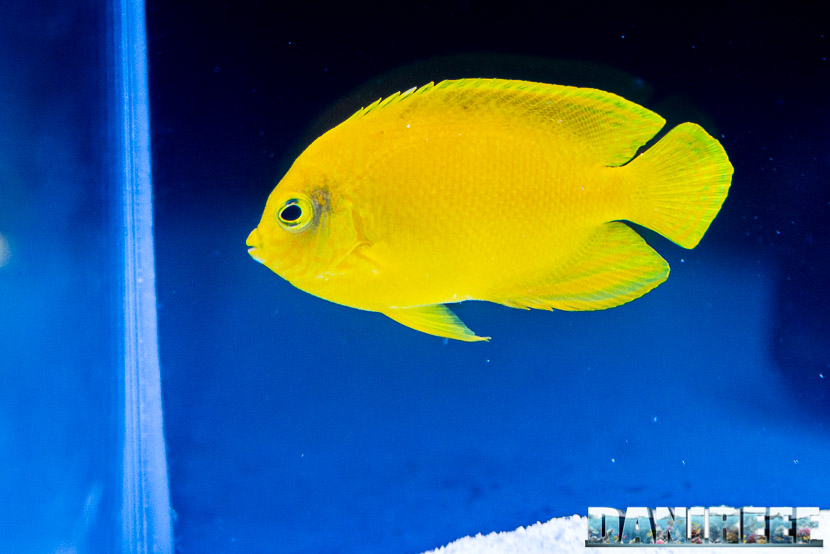
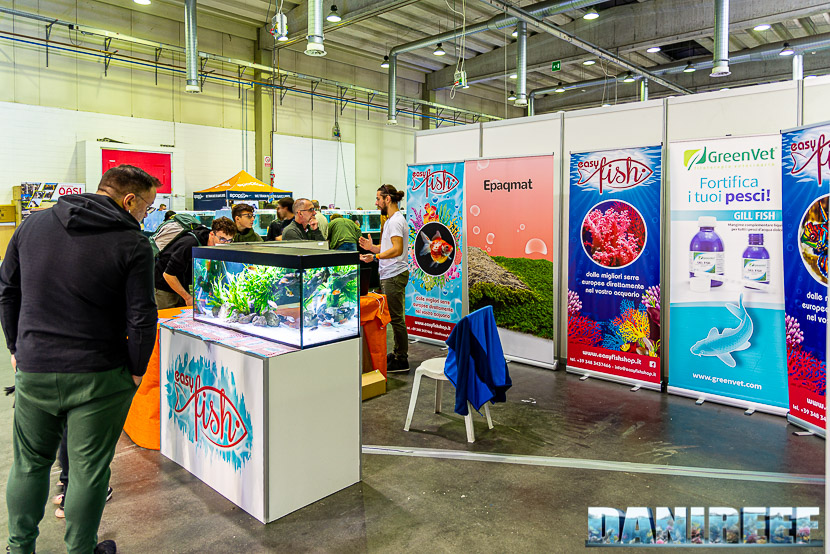



Wow dani, great photos on a (almost beautiful looking!) pest. I currently have a small patch of hydroids next to the base of an A. horrida. They haven’t moved in months, just a little group of them. I do not think I have the same species as you, but bookmarking this post to check!
[…] […]
Myrionema : articolo veramente esaustivo. Ora sappiamo molto di più…
Una puntualizzazione dovuta: il myrionema non è affatto così diffuso in acquario ma piuttosto raro.
[…] has an excellent article on dealing with those little pesky […]
Dany cacchiarola, così mi dai brutte notizie, vuoi vedere che le ho in vasca ?! ti faccio sapere.
bellissimo articolo 😉
Sandro, spero proprio di no!
Hallo Dani!!
I must admit that after reading your article i ordered Centropyge loriculus for my tank.
I got that hydroid infestation and it grew everywhere in my tank.
After getting flame angel, it dissapeard in a matter of two months.
Important thing is that I have NEVER seen Flame angel eating it, but today I don’t have any Myrionema amboinense in my reef tank!
Thank you for your info and time spend writing your article!
Feel free to visit us Croatian reefers at our reef forum reefclub.info… I will open international forum board just in case you drop by and maybe present your aquarium to us!!
Keep on reefing, and one more time – THANK YOU!
CHEERS
Vedran Stincic
Hello Stina!
Thanks for your comment. I’ll visit your forum for sure 🙂
Danilo
bravo Danilo, sentivo a voce parlare di questo problema da te e maurizio zannoni ma qui ne hai descritto ogni dettaglio che per chi ha passione come noi giovani acquariofili molto utile conoscere questo perchè sono cose che normalmente non si imparano frequentando semplice negozi di vendita di vasche o pesci e dico di più e il vero: se non ci fossi tu e Maurizio mai avrei iniziato questa stupenda avventura. Grazie
Grazie Gianluca
[…] Mirionema amboinense […]
[…] Esta en italiano e ingles, y no se si es exactamente la misma especie que la mia, pero vale igual: Myrionema amboinense : DaniReef – blog sull'acquario marino En fin, que muchas gracias a todos por ponerme sobreaviso. Un saludo, os mantendre informados… […]
[…] al Myrionema amboinense, sul quale esiste già un bellissimo articolo su DaniReef.com “Myrionema amboinense” sebbene abbia un taglio molto meno biologico. AKPC_IDS += "3072,";Popularity: 1% [?] […]
[…] un commento Dopo l’articolo sui Myrionema che ne parlava dal punto di vista dell’acquariofilo puro, e dopo l’articolo della […]